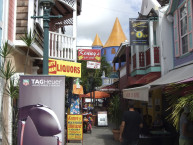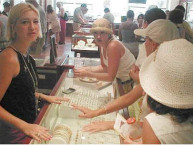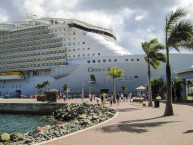Ruby
Ruby is one of the world’s rarest and most expensive of gemstones. And although most of these stones are found in the Far East, the Caribbean offers some excellent values in rubies.
Ruby is the name given to the red variety of corundum and the color should be fairly intense red or else it will be a pink sapphire. The finest color of ruby will be the pigeon-blood red color that is intensely red with no overtones of purple. Strong overtones of purple will affect the price of the ruby rather quickly.
The finest color of ruby will be the pigeon-blood red color that is intensely red with no overtones of purple. Strong overtones of purple will affect the price of the ruby rather quickly.
Most rubies will contain inclusions. Stones of strong red color and very few inclusions are quite rare and expensive. Most, however, will contain inclusions that are visible to the unaided eye.
As part of the customary finishing process, virtually all rubies are heated to permanently improve their color and appearance.
When shopping for rubies always look for color first, clarity second. When looking at the stone it should appear bright and intensely rich. Pass on the stones that are dull or overly dark or overly light. Ruby tends to be more included than sapphire, look for stones that are ” eye-clean ” ( no inclusions visible to the unaided eye) Though an exception to this is extremely fine silk throughout the stone which can actually enhance the beauty of certain rubies. This silk is necessary to create the star effect, see below.
The cut of the stone is important. It should be symmetrical, free of nicks and scratches. When light hits the stone the center should not have a dark patch or a washed out appearance. If these appear it means the cut of the stone is either too shallow or too deep. In rubies the most common cuts are oval, cushion and round. Less common are heart and emerald cut. Due to the rule of supply and demand slight premiums are paid for round stones, while slight discounts apply for pear and marquises.
A well cut Ruby of deep red color seems to have an inner glow about it, which is why many ancient religions held the ruby in high esteem.
Star Ruby: A ruby that creates an eye or a star is called a phenomenon or phenomenal gemstone. Naturally, these gems are sought worldwide by connoisseurs. When ruby or sapphire is discovered filled with rutile (silk), some may be cut cabochon (domed), and occasionally they produce a six-legged star. The essential element in producing a star ruby or sapphire is rutile. The more densely packed the rutile, the better the star. When light is reflected from the crystals it produces a “sheen”. Asterism occurs when the light is concentrated into three rays that intersect at right angles to the direction of the needles, thus creating a six-legged star. As most know, these stones usually only star in sunlight or under strong indoor light. Of course, the synthetic stars star perfectly in all lights, which makes them simple to detect. African and Thai corundum do not produce stars due to the lack of rutile in the material. Only Sri Lanka and Burma produce these wonderful stones. Naturally, the Burma material is the most coveted. Star ruby from Sri Lanka tends to be purplish brown.
Asterism occurs when the light is concentrated into three rays that intersect at right angles to the direction of the needles, thus creating a six-legged star. As most know, these stones usually only star in sunlight or under strong indoor light. Of course, the synthetic stars star perfectly in all lights, which makes them simple to detect. African and Thai corundum do not produce stars due to the lack of rutile in the material. Only Sri Lanka and Burma produce these wonderful stones. Naturally, the Burma material is the most coveted. Star ruby from Sri Lanka tends to be purplish brown.
Sizes of Ruby
Many factors are considered when pricing a ruby, size is one of these factors. Rubies of fine gem quality are rare.
Small, low quality rubies can be found for a few dollars a carat. These are usually not clean enough to facet, are of poor quality, fracture easily and are disappointing to say the least.
A large fine gem quality Ruby above two carats is an extremely rare stone, and untreated fine quality rubies above 5 carats are considered “world-class”.
Between these two extremes lie the fine quality rubies found in jewelers cases today.
Origins of the finest Ruby’s
1: Mogok, Burma
2: Sri Lanka
3: Madagascar
4: Nanyazeik, Burma
5: The rest of the world
Helpful tips for buying ruby’s
So you’ve decided a ruby is for you. We have a few suggestions for you before you buy.
First, decide what price range is comfortable for you. Decide what your limits are before that fabulous gem is before you, tempting and teasing you.
Second, visit your local jewelers before your trip and have them show you their selection of Rubies. Note the color, size, quality of cut, price per carat and materials used in the jewelry. Bring these notes along on your trip to the islands and compare these to what they have to offer. You are now an informed consumer.
Always view your prospective ruby purchase under proper lighting. We are constantly amazed at how many jewelers have improper lighting for viewing gems. Fluorescent lights work wonderfully for doing paperwork in the office, however they are “red deficient” and so make assessing colored gems a nightmare. Ask to view the ruby under a variety of lights, such as incandescent and daylight.
The background color the ruby is placed on will also affect the color of the stone. An old trick was to place the ruby on a brass plate, or yellow table top. This makes the less desirable purple-red stone appear more reddish. Place the ruby on a white white background for an accurate color assessment.
Another old trick when buying parcels of rubies was to pile them all together. The rubies then all draw color from one another, making the parcel as a whole appear better than they are. If you find yourself in this situation, simply take your hand and spread them all out, again on a white cloth, so that the individual gems are not affected by the color of those near it.
As we stated earlier, the majority of rubies on the market today have been heat treated to enhance color and in no way affect the stability of the stone. Heat treating of rubies has been going on for over one thousand years. The simplest is low temperature heating to knock out the blue component which makes a ruby purplish. Another treatment that involves higher temperatures to remove rutile silk. These treatments merely enhance the qualities of the ruby and do not affect its stability. It does affect the price however, because a natural ruby with absolutely no treatments of fine quality will demand a high price.
It is absolutely essential that sellers disclose to buyers that a gem has been treated. Especially in the case of the Mong Hsu Rubies. This treatment involves heating in the presence of a flux. The flux produces healing of surface-reaching fractures and openings. A highly fractured stone can be healed and the fractures dissipated. One further treatment occasionally seen is oiling/staining. These treatments greatly influence the stability and value of the stone. These are treatments which need to be disclosed at the time of sale.
If the above information has you confused, ask your jeweler to see the rubys that come with a certificate from a major gem lab. A CGI certificate means that the piece has been individually looked at by a graduate gemologist under a microscope, color assessed, size of stone measured and treatments, if any, disclosed. If the jeweler states you “don’t need this”, find another jeweler. For a list of CGI approved jewelers please click here
Some ruby dealers know that the weather as well as time of day will affect a gem’s look. Cloud cover will enhance a ruby’s color (less sky blue), whereas clear blue skies will give the stone a purple color. Light-colored ruby looks best under dim lighting (candlelight, low wattage incandescent lights, sunrise or sunset – roughly equal to 1,800 degrees Kelvin), and dark ruby looks best when the light is brightest – i.e., direct noonday sun. In fact, because of the smog and latitude of Bangkok, it is said that ruby that looks dark in Thailand will look even darker in the United States. Smog will actually lighten a blue sky. In cities with less smog, the darker blue sky will dull and darken a red gem. To make matters more complicated, light takes on a totally different color when seen indirectly – for example, inside at a north-facing window. In the morning, the light is bluish: from 11 a.m. to 1 p.m., it’s a lighter, whiter blue. It shifts back to a more bluish color late in the afternoon.
The highest price per carat ever paid for a ruby was Alan Caplan’s Ruby ( Mogok Ruby ) a 15.97 carat faceted stone that sold at Sotheby’s New York in October of 1988 for $3,630,000.
Until improvements in chemical testing in the 1800s, most red gem-quality stones were called rubies. Many of the famous “rubies” in the crown jewels of Europe have since been identified as red spinels or garnets.
Large rubies are incredibly rare and can cost more than diamonds. In the thirteenth century, traveler Marco Polo wrote that Kublai Kahn, the Mongol Emperor of China, once offered an entire city for a ruby the size of a man’s finger.
In ancient times the King of Ceylon was said to possess a ruby that shone so brightly that when he brought it out at night, it would light up the entire palace.
Rubies are said to protect their owners from all kinds of misfortune. A fine ruby assured the owner he would live in harmony with his neighbors. It would protect his stature in life, his home and land.
Its protective powers were intensified when set in jewelry, and worn on the left side. Many believed rubies possessed an inner flame which burned eternally.



